
I am from an age where monolithic shopping centres rose from the barren earth like cathedrals. The height of sophistication was a food court at the top of a mile-high escalator, offering at least thirteen pseudo-American bastardisations of various international cuisines. Shoppers zig-zagged wide-aisled malls bedecked with palm trees, stalls selling ugly silver jewellery and spare Pop Swatch straps, and Slush Puppie carts. Above them, a huge glass dome, or abundant trails of plastic flora; to their left, vast atriums plunging Niagara deep to Car Park F; and to their right, branches of Benetton, Schuh, JD Sports, Gap, The Sweater Shop, and Next as far as the eye could see. Brass rails gleamed in the sunlight, the floor spelled out the shopping centre’s initials or featured diamond patterned mosaics. The only sounds you’d hear would be indistinct, yet tightly licensed, wordless muzak, excited chatter, and the rustle of thick, glossy plastic bags that didn't cost a penny and, somewhere out there, leak poisons into a once-beautiful river even to this day. Meadowhall! Metro Centre! Trafford Centre! Lakeside! Each one offering a religious experience no city centre wannabe could ever replicate.
The big four from the nineties are still going strong, with many more additions across the country, including Westfield’s oppressive Death Stars bookending London in Shepherd’s Bush and Stratford. But as tastes change, and planners’ palms cry out for grease, some shopping centres get left behind. Off-white matte tiles, ornate railings, and deep green and maroon marble-effect corinthian pillars switched from being the apex of cool to the deepest well of cringe. Overnight, once-stylish shopping havens became sad and pathetic. Their more credible tastemaking tenants hastened to shinier floors and more salubrious surroundings, leaving behind only half-empty vending machines, household reject shops and stores selling polyester tank tops emblazoned with ‘S L U T’ or ‘H U S T L E R’ in wonky letterman typeface.
In 1994, I began university in Southampton and was immediately transfixed by its two shopping centres, at opposite ends of the main drag. At the top, and thus first port of call for any students descending from their hazardous rentals, was the Marlands – all brass and pillars and glass lifts and climbing vines. It was charming in its own way, and still pretty busy, counting among its tenants Pilot, Mark One (later to become mk1, and eventually become nothing), Athena, Tie Rack, Whittard, Raw shoes, The Perfume Shop – all the greats. Its main selling point was a fake Georgian street within, which housed little boutiques mainly selling very tight knitted polo shirts to men who could lift a Vauxhall Nova above their heads, and at one end, a coffee shop called Brophy’s where almost everyone at my university worked for precisely one Saturday before quitting. Bustling as it was, it had the stench of death about it, the branding was looking tired and the fixtures getting shabby. But it was in rude health compared to its rival, the much more modern, yet serially unloved Bargate Centre. Oh, the poor Bargate. So misunderstood.
My sharpest memories of the Bargate are:
1. Getting my nose pierced there in the second week of term for £8.
2. Trying boysenberry juice for the first time.
3. The hench Egyptian god statues dotted around the atrium for no apparent reason.
The Bargate, although shiny and promising, was roundly ignored by locals the entire time I was there. There was nothing of note inside I can remember, aside from the upmarket salon I paid to attack my nose with a piercing gun, a surf shop called Moist (which always made me gag because I used to be one of those people who pretended they hated the word ‘moist’), and a hippy outlet called Diabolo – ffs – selling rag rugs, oil burners, and the kind of patchwork trousers destined to fall victim to a drug-induced poonami attack during a Chemical Brothers set at Glastonbury. As I often do with inanimate objects, I began to feel sorry for the Bargate, and made a point of going in whenever in town to pace its abandoned mall – and buy some boysenberry juice. I checked on Street View and it’s been demolished now, while the Marlands apparently clings on.
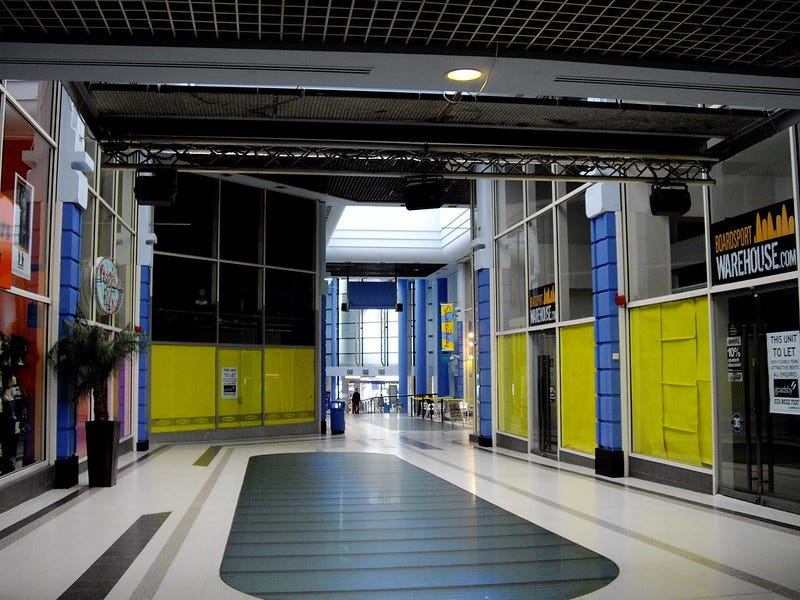
So began my affection for ‘dead malls’, capitalism’s follies that either fell out of favour or never found it in the first place. The Waverley Market in Edinburgh, which has staggered on these last twenty-five years through name changes, rebrands and all manner of pop-ups, while its auld rival, St James Centre – the ugliest shopping centre ever to house a John Lewis – was bulldozed and replaced by a sleeker, more futuristic vision: slate, chrome, olympic stadium lighting, a Harrods beauty hall with a dystopian champagne bar. Nottingham’s Broadmarsh, glitzed up out of its seventies doldrums in 1988 only to have a relapse and end up half-demolished. The W12 centre across the road from the mammoth Westfield in Shepherd’s Bush, the patient refusing to acknowledge its terminal diagnosis, soldiering on thanks to a couple of pound shops, a doctor’s surgery (?!) a Pizza Express, a Wetherspoons, an oriental buffet, and a decent Lidl. In Bradford, the Kirkgate centre is a beacon of depressive stoicism, sitting undefeated in a part of town so successfully de-gentrified by the council’s planning department, it makes Sutekh’s obliteration of all life in the universe look like a goodnight kiss. Despite the best efforts of Bodycare, Primark, and New Look, it feels like the end is near for the multi-storeyed concrete tomb. Its killer? A Westfield ten minutes’ walk away, itself already beleaguered by closures – M&S shut its doors last month after over a century in Bradford. The buzzards are circling.
I finished the first draft of my debut novel The Last Romeo in March 2017, sitting in the Starbucks inside the ghost of the Whiteley’s Centre. Once a glamorous department store but when they fell out of fashion, converted into a shopping centre – very common, hello to the long-dead Schofields Centre in Leeds! – Whiteley’s was the epitome of late 80s destination shopping. It was still beautiful in its near desolation: sweeping staircases, ornate pillars, marble tiles, the inevitable brass balustrades. Barely a shop open – aside from M&S and a Zara – and its toilets sparkling but in desperate need of condemnation, it’s amazing the Whiteley’s lasted a full eight years after the nearby Westfield (again) opened its doors. Like a faded beauty queen riffling desperately through her old headshots searching for who she used to be, Whiteley’s still carried a proud and luxurious air that no amount of ‘3 scarves for £10’ popup stalls could diminish.
But there is a different kind of dead mall that lacks the charm of our once-lovely veterans – the living dead, you could say.
Battersea Power Station, a beautiful building, certainly, painstakingly saved from dereliction after decades of wrangling. Yet the finished complex is the oddest, most vibeless setting. The air feels choked by microplastics, the cynical interior lighting the same hue as Laura Palmer’s corpse. Its outdoor areas are sterile, concrete prairies, as if snipers hide among the iconic chimneys picking off locals insufficiently gentrified to browse the mall’s Rolex outlet, or Kooples, or the elite air-fryer shop. Everybody is looking, but nobody is buying, save for Nike and Adidas, and the food outlets, with reassuringly long queues for a £7 ice cream cone or a Pret baguette. The punters, largely, look like they make one-night-stands sign NDAs and have almost certainly thrown a phone at their cleaner. Jacked Patrick Batemans who like having champagne poured into their cum-gutters, and whose only interaction with the working classes is to buy drugs from them, wearing high-performance athletic wear or nonchalant fashions in oatmeal. And their high-ponytail companions with televangelist smiles, who’d wear their favourite mint green Nike running leggings even to a funeral, and have been the subject of numerous Instagram hate pages concerning decades of school and workplace bullying allegations. I’m not perfect, in fact I’m no better than the hollow demons I criticise: I go there to haunt the M&S – they closed my local – and who can resist a nose round Uniqlo, but once there, a headache quickly descends, along with the feeling I will only ever be a temporary invitee to this cult of wealth that thrives on identikit experiences in increasingly opulent surroundings. At least there's a decent bookshop, I suppose.
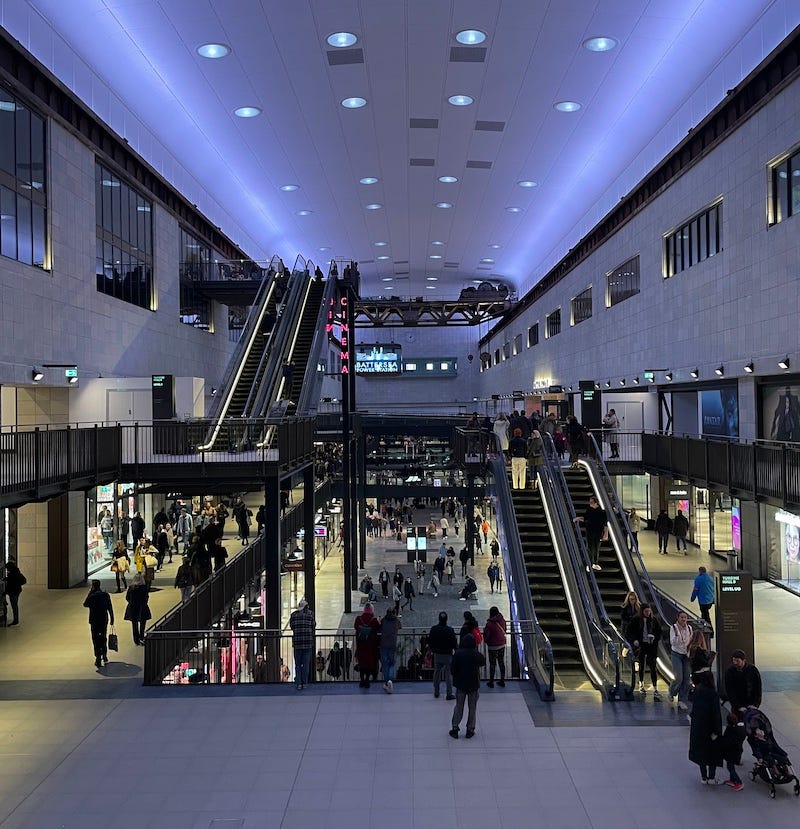
The impressive Power Station itself is open to the river on one side yet its rear is buffered by a wall of ugly, soulless apartments to screen the development from the social housing across the road, lest we remember we’re in Battersea, where real people also live, and not Chelsea just across the bridge. At the moment, despite a large number of the retail units offering the kind of products even the super-rich buy no more than once a year, it is hectic, soundtracked by the satisfied tinkle of heavy cutlery on porcelain under parasols, and the honeyed laughter of the generationally rich. But when the next development opens, the laughter fades, and the smarter shutters start rolling down, what then?
Then, I’ll be back, to wander its malls and dredge up some sympathy. Until then: I wish them well.
What’s your favourite dead mall, past or present? Let me know in the comments and we can light a candle together.


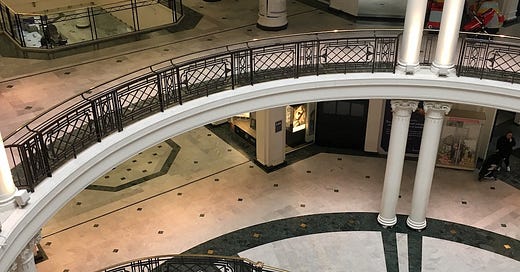


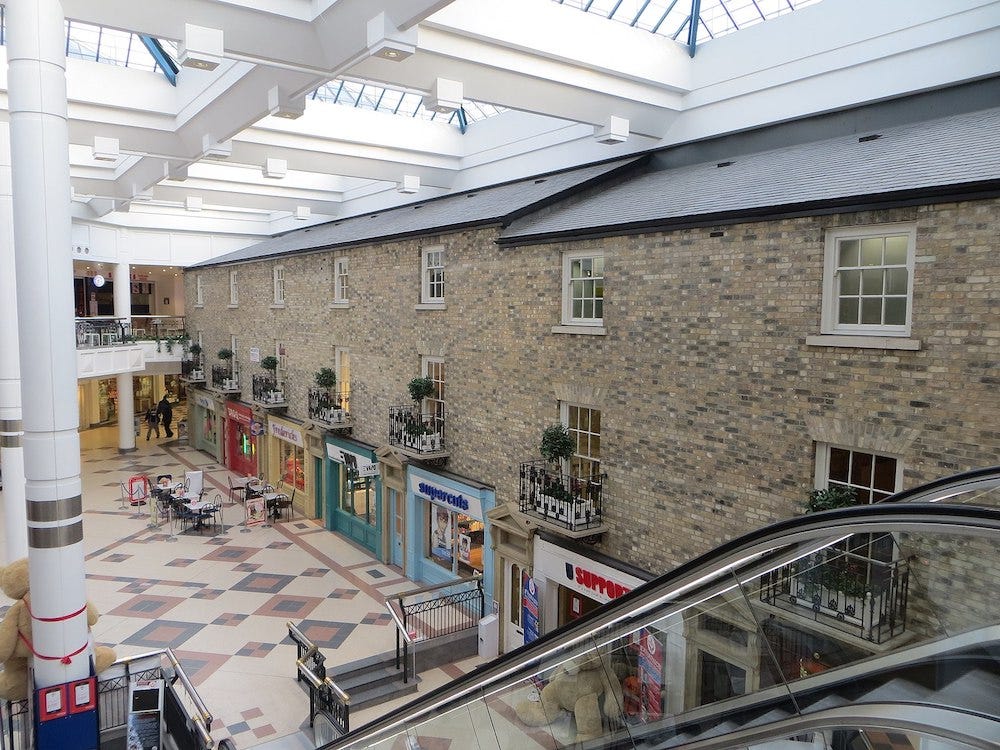
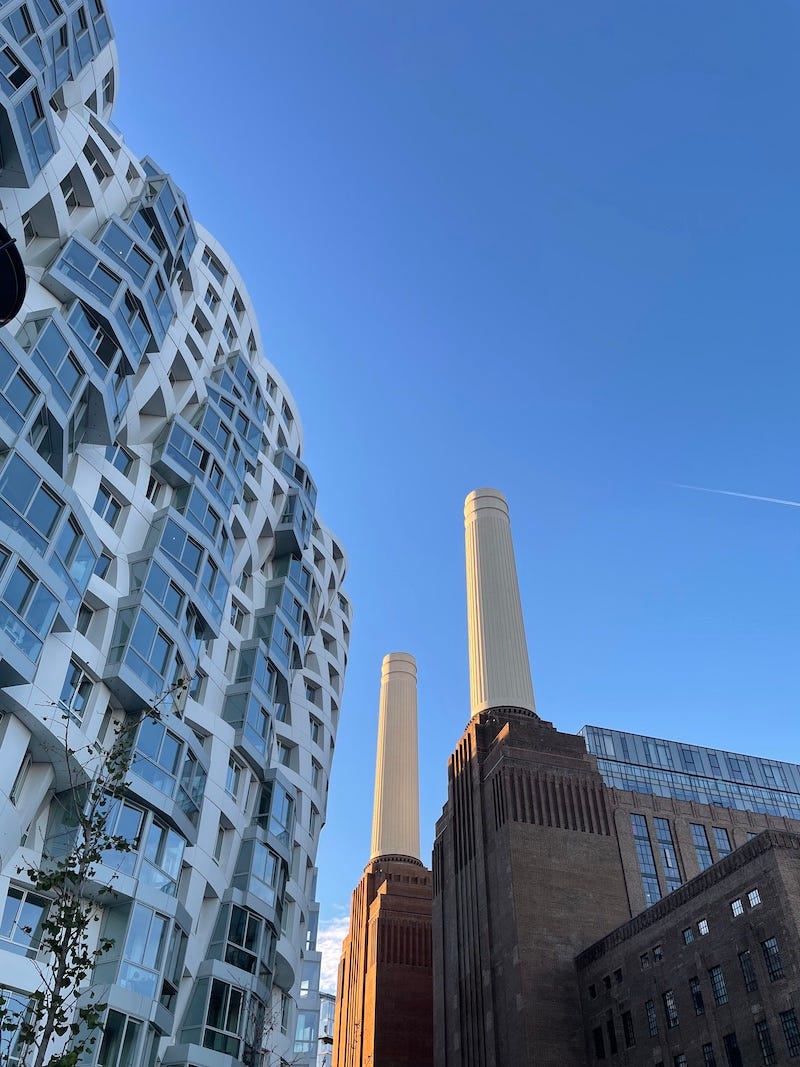
In celebration of this article, I highly recommend a visit to Croydon's not-yet-dead, yet not-quite-alive-either Whitgift Centre, if you haven't already. I visited so many times during lockdown and, whilst those times were undoubtedly more apocalyptic than general times, it very much feels like a relic. (PS Thanks for bringing back my Meadowhall memories... for me, trips there were all about the bonding experience with my mum, so I have fond memories whenever I drive past it these days) x
Going to Brent Cross as a pre-teen was like a trip to another world…kaleidoscope lights, fountains, Fenwicks, giant wooden turtles (no me neither) oh I loved it.